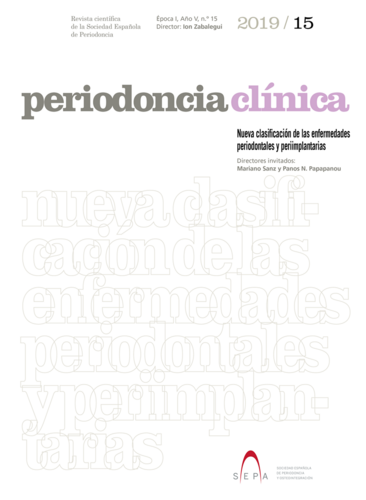![]()
9 January 2020
SEPA publishes magazine with EFP toolkit on new classification plus case studies
Categories:New Classification, National Activities

The Spanish Society of Periodontology and Osteointegration (SEPA) has dedicated the latest issue of its Periodoncia Clínica [Clinical Periodontology] magazine to the toolkit on the new classification of periodontal and peri-implant diseases developed by the EFP.
The magazine, available to SEPA’s 6,000 members, provides translations of the guidance notes for clinicians produced by the EFP co-chairs of the 2017 World Workshop on the Classification of Periodontal and Peri-implant Diseases and Conditions and published by the EFP in April 2019.
This issue of Periodoncia Clínica includes full translations of the guidance notes by Iain Chapple (Periodontal health and gingival diseases and conditions), Mariano Sanz and Maurizio Tonetti (Periodontitis and the clinical decision tree for staging and grading periodontitis), Søren Jepsen (Systemic and other periodontal conditions), and Tord Berglundh (Peri-implant health, peri-implant mucositis, and peri-implantitis).
In addition, the magazine provides specially commissioned case studies in which the new classification’s approach of staging and grading periodontitis cases is applied retrospectively to specific patient cases.
Written by a team of Spanish periodontists (Ion Zabalegui, Ignacio Sanz Martín, Ana Marcos Terán, María Rioboo, and Marta Escribano), the case studies cover: generalised gingivitis; generalised periodontitis, stage I, grade B; generalised periodontitis, stage III, grade B; Periodontitis, stage III, grade C; and generalised periodontitis, stage IV, grade C.
The next issue of Periodoncia Clínica will also focus on how to implement the new classification in everyday clinical practice.
SEPA’s publication of the guidance notes follows the publication of translated versions in French (by the perio societies of France, Belgium, Switzerland, and Morocco) and German (by the perio societies of Germany, Austria, and Switzerland).
‘Excellent tool’
“As president of the EFP workshop committee and member of the organizing committee of the World Workshop organised by the American Academy of Periodontology and the EFP which approved the new classification of periodontal and peri-implant diseases, I would very much like to thank SEPA for the initiative of publishing a special issue of its Periodoncia Clínica magazine dedicated to this classification,” said Mariano Sanz, chair of the EFP workshop committee and co-ordinator of the new-classification toolkit.
“This issue not only presents with clarity and with an excellent iconography the classification criteria of the various diseases in different sections, but also presents five demonstration clinical cases, which use the recommended decision-making trees, using excellent imagery and a text that is very easy to follow and understand. It seems to me to be an excellent tool for promoting the use of the new classification to all Spanish-speaking professionals.”
“SEPA’s commitment to its federation is fundamental to widening the dissemination of the new classification of periodontal and peri-implant diseases via Periodoncia Clínica, SEPA’s scientific and clinical magazine,” said the magazine’s editor Ion Zabelgui.
“This monographic issue of Periodoncia Clínica, which featured Mariano Sanz and Panos Papapanou as guest editors, is one step more in SEPA’s important outreach work, in a way that a large number of Spanish-speaking periodontists and general dentists can know at first hand the materials published by the EFP, as well as a series of clinical cases that help to improve understanding of their clinical application.
“To this end, the next issue of Periodoncia Clínica – in the new period under the editorship of Ignacio Sanz Martín – will have Filippo Graziani [EFP president] and Adrián Guerrero [SEPA president 2016-2019] as guest editors to go deeper into how to implement in clinical day-to-day practice the scientific consensus provided by the new classification, whose ultimate beneficiaries must be both oral-health professionals and patients.”




